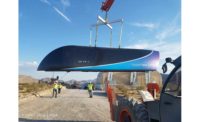Colorado Gov. John Hickenlooper (D) has ordered comprehensive inspections, along with new monitoring and testing procedures, for all oil and gas pipelines located near houses and other buildings across the state. The action follows an April gas explosion in a northern Colorado home that killed two people.
Hickenlooper gave oil companies working in the state 30 to 60 days to locate and test flowlines within 1,000 ft of any occupied building and called for all pipelines, whether operating or not, to be mapped and their locations made public.
Colorado currently maps all oil and gas wells in the state but does not maintain a database of underground pipelines. The governor also ordered that all abandoned pipelines at least 3 ft below the surface be marked, cut and capped.
"I don't think it's unreasonable for that to be public information," Hickenlooper told the press after the announcement. "It would probably take legislation … but their locations should be a matter of public record."
Democrats in the Colorado statehouse proposed a bill near the end of the 2017 legislative session that would have forced oil and gas companies to reveal the locations of all pipelines and for the state to map them and create a locator database. The proposal, which was opposed by industry groups and most Republicans, was killed during the last day of the session on May 10.
Meanwhile, in the north Denver suburb of Thornton, officials announced that the city will begin publishing reports on all oil and gas wells operating within the city limits and will update its rules to inform and safeguard the public about well operations. "The safety of people living and working in Thornton is of primary concern for the city council," city leaders said in a statement.
Uncapped Lines
These actions and the governor's May 2 directive arose in response to the April 17 explosion that destroyed a home in Firestone, Colo., north of Denver. The blast killed two men working on a hot water heater in the home's basement and critically injured a woman inside the house.
The governor called the incident "a tragedy of immense intensity" and vowed that it would never happen again.
Local fire officials said the commercial gas line to the house had been turned off, but investigators determined that the explosion was caused by a buildup of methane and propane leaking into the home's basement from an open pipeline buried about 7 ft below ground and severed only 6 ft from the foundation.
It is still not clear how the flowline was cut, and even though investigators believe the line was abandoned and had not been capped, it remained connected to a working gas well owned by Anadarko Petroleum Corp. The well is situated less than 200 ft from the house, although investigators said the home's proximity to the well likely was not related to the explosion.
An investigation conducted after the blast revealed that the switch for the uncapped flowline was in the open position. Fire officials say that the odorless, colorless gas probably seeped into the house from the ground through a sump pump pit and a French drain. Officials say that a simple pressure test, had one been done, could have shown that the pipe was cut and had not been capped.
However, no comprehensive programs are in place to test and monitor pipelines. The Colorado Oil and Gas Conservation Commission, which oversees the industry for the state, mandates that pipeline owners or operators notify the commission and local municipalities about abandoned flowlines, which must then be drained and sealed. But COGCC admits it doesn't know where all the pipelines are located. The agency has only three employees to monitor and test the state's 53,000 wells, and those personnel have been in place for only a year.
Local municipalities work with developers and contractors to determine where building is permitted in relation to existing pipelines. Among the options being considered by the state are increasing the number of well and pipeline inspectors and improving monitoring procedures. That could include requiring well operators to tighten their mapping and testing protocols.
Anadarko shut down 3,000 of its vertical wells in northeastern Colorado on April 27, out of "an abundance of caution," the company said in a statement. Anadarko is one of the largest well operators in the state. Al Walker, Anadarko president, said the company is "very saddened by the events in Colorado" and will "work very hard to understand it better." Still, Anadarko says it plans to increase its drilling operations in northeastern Colorado.
Potential clashes between oil and gas operators and homeowners have been exacerbated by Colorado's rapid growth and high in-migration, which is especially acute north of Denver. Weld County, where thousands of wells are located, is one of the fastest-growing counties in the country. The home leveled by the blast was part of a new housing development in the area.
The Firestone blast is reminiscent of a 2010 gas explosion in San Bruno, Calif., where a ruptured Pacific Gas & Electric natural gas pipeline erupted into a wall of flames more than 1,000 ft high. The blaze leveled 35 houses and killed eight people, most of them in their homes.
A 2015 gas leak in Southern California's Aliso Canyon arose from the second-largest gas storage facility of its kind in the U.S. More than 100,000 tonnes of methane and ethane gas were released into the atmosphere, making it one of the worst single natural gas leaks in U.S. history in terms of environmental damage.



